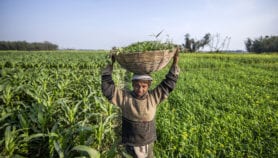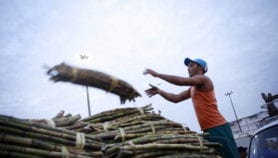By: David Dickson
Send to a friend
The details you provide on this page will not be used to send unsolicited email, and will not be sold to a 3rd party. See privacy policy.
A decision by the Indian government to approve the commercial planting of genetically-engineered cotton gives it a heavy responsibility to take effective steps to ensure their safe and equitable application.
Last week's decision by the Indian government to give the green light to the commercial planting of three varieties of transgenic Bt cotton that have been genetically-engineered to resist the destructive bollworm (see 'India approves cultivation of GM crops'), did not come as a great surprise. Whatever the scientific arguments, the government's Genetic Engineering Approval Committee (GEAC) has long been under considerable pressure, both from many of its own farmers and from foreign seed manufacturers, to take such a step.
Furthermore, a decision by the same committee last year to postpone such a judgement, based on the argument that there was insufficient information on experimental field trials, seemed to many also to reflect a desire by the government to buy time before committing itself to a step destined to provoke widespread protest.
The government's sensitivity to public opinion, reflected in the widespread condemnation of last week's decision by various environmentalist groups, only underlines the significance of its decision. It has attempted to mollify some of this opposition by attaching stringent conditions to the way in which the crops can be used. For example, reflecting an awareness of the dangers of genetically-modified (GM) plants escaping into the local environment, it will require that all such planting be surrounded by a strip of non-Bt cotton, between 2 and 2.5 metres in width.
But the decision is being widely seen, both by the agrobiotech industry and anti-GM protestors, for what it essentially is: a green light to those in India's agricultural industry to adopt GM technology. Approval for other GM crops, such as wheat, maize and even rice, is now expected to follow. Furthermore, the move is likely to have important international consequences. It will send a signal to other, smaller countries, who may feel that they cannot afford not to follow in India's footsteps.
Legitimate concerns
Much of the scientific and economic logic behind the GEAC's decision is difficult to contest. In particular, the committee accepted evidence that by substantially reducing the need for pesticides, planting Bt cotton could cut the costs of growing cotton by almost US$200 a hectare.
Even those who argue that this figure could be significantly overestimated, accept that the reduced costs of pesticides will be a major saving for farmers (revealingly, one rumour about last year's delay was that it had been prompted by lobbying from the pesticide industry, well aware of the impact that such a move is likely to have on its profits).
Nevertheless, there is much in the protesters' arguments that needs to be kept in mind. Firstly, there is the often-quoted danger that the bollworm will develop a resistance to the toxins contained in Bt cotton, making the current strains ineffective. Optimists argue that, if this happens, the companies behind the technology will find a technical fix; pessimists point out that, if they don't, farmers that have come to rely on the new strains could end up in 10 years' time even more vulnerable to bollworm than they are today.
Secondly, the conditions being placed on the planting of Bt cotton will require strict enforcement — and parts of the country have not had a strong track record in this area. The government suffered a major embarrassment last year when it was discovered that thousands of acres of Bt cotton were being illegally planted in the state of Gujarat with seeds provided by a local company that had decided blatantly to ignore the ban then in force.
States, whom the GEAC has said should take responsibility for regulating compliance with its conditions on planting Bt crops, will need to accept that their failure to apply the rules effectively could threaten not only environmental safety, but also public confidence in their commitment to ensuring such safety.
Social impacts
Thirdly, it seems inevitable that the decision to allow the planting of Bt cotton will (just like the Green Revolution before it) favour large, well-capitalised farmers. Small-scale farmers are likely to find it much more difficult to benefit from the new crops, if only because the planting conditions (such as the required 'safety strip') will be proportionately a much more onerous commitment.
Indeed, it is widely anticipated that the broad-scale introduction of GM crops heralded by last week's decision could push many small-scale farmers over the brink into bankruptcy. Already Andhra Pradesh, one of the states that is keenest to adopt new GM crops as the key to boosting its agricultural productivity, has already indicated its desire to reduce the number of people employed in agriculture from 70 to 40 per cent over the next 20 years.
None of these arguments was, rightly, considered sufficiently powerful by the GEAC to justify refusing to permit planting of Bt cotton. But each remain strong enough to place a heavy responsibility on political authorities in India to ensure that a firm grip is held on the environmental and social threats that they contain. GM crops offer benefits at many levels. But these benefits will only materialise if those — including government bodies — responsible for monitoring their introduction successfully avoid the problems that such crops, if inadequately regulated, could quickly give rise to, and ensure that the benefits of their introducion are distributed equitably.
© SciDev.Net 2002













